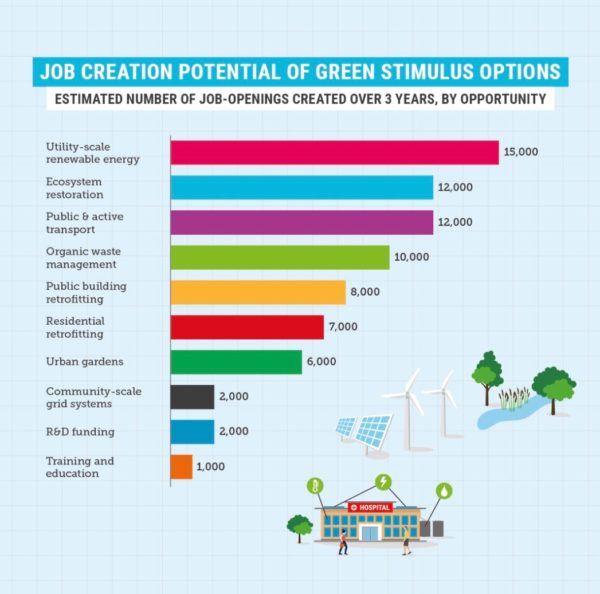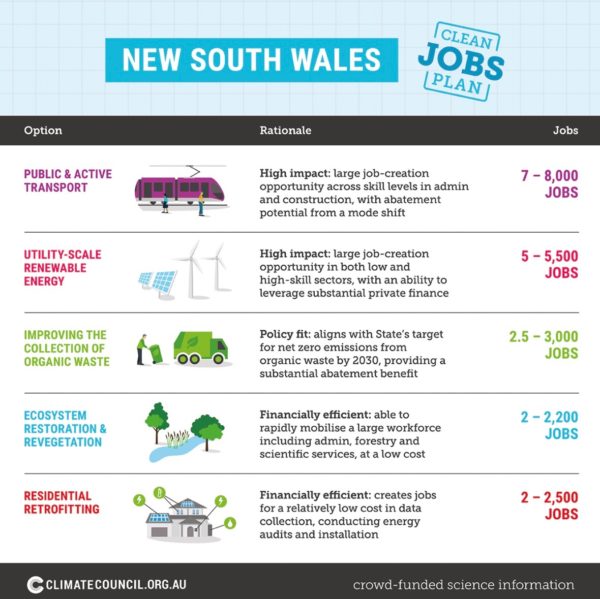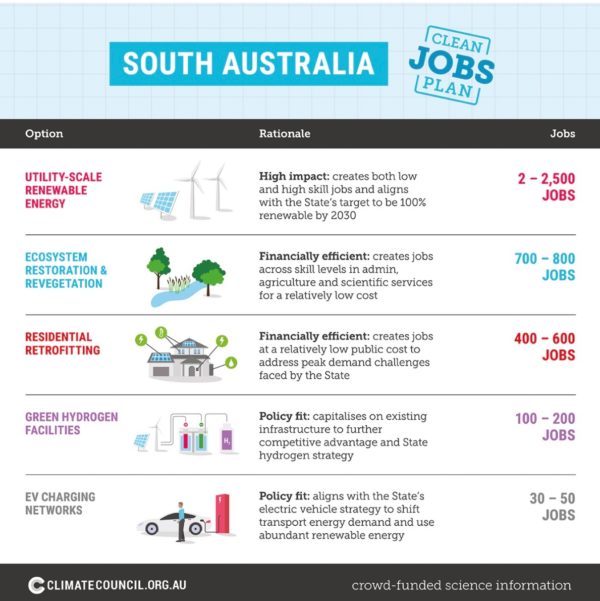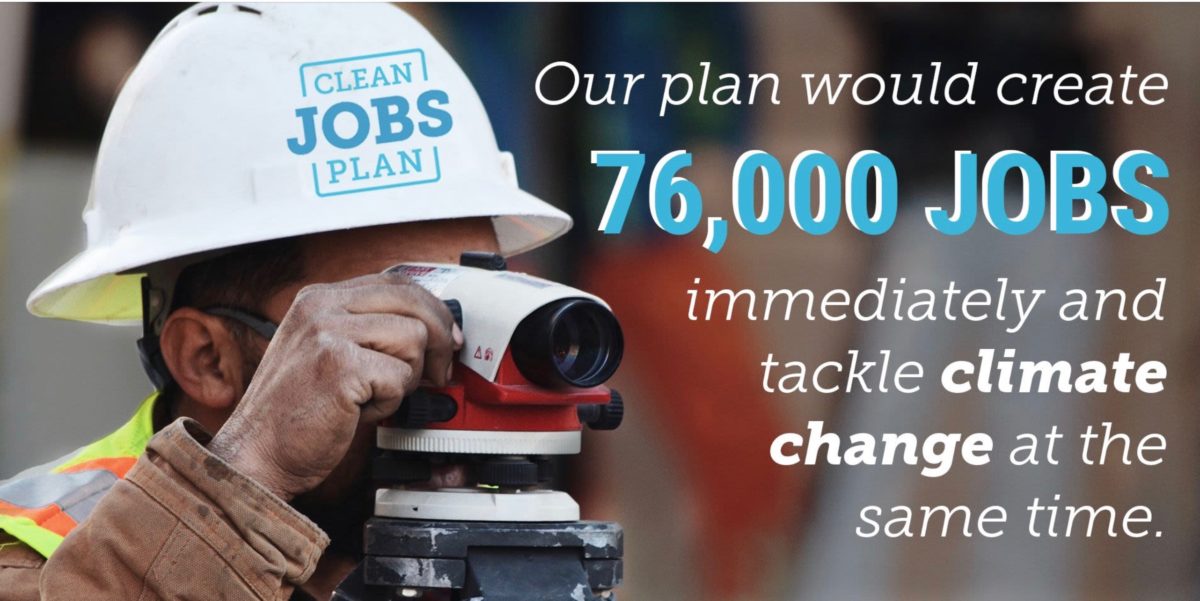According to new economic modelling published by Accenture’s AlphaBeta and commissioned by the Climate Council, 76,000 clean jobs could be created nationwide over the next three years in a green economic recovery to the impacts of Covid-19.
AlphaBeta’s “The Clean Jobs Plan” (Plan) sets out a dozen policy options which would accelerate sustainable job creation for, in the words of AlphaBeta Director, Andrew Charlton, “the people who need them most.”
The Plan has been released on the back of a personal plea from Clean Energy Council (CEC) Chief Executive Kane Thornton to Canberra to allow the renewable energy industry to lead the Covid-19 economic recovery, and think-tank Beyond Zero Emissions’ (BZE) publication of its Million Jobs Report, in which a green scaffolded economic recovery which posits 1.8 million new jobs can be created through renewables and low emissions projects over the next five years. This latter Report already has strong support, including Mike Cannon-Brookes, Ross Garnaut, Malcolm Turnbull, Kevin McCann, and Christiana Figueres.
Christiana Figueres, one of the UN architects of the Paris Agreement, said she was extremely excited about BZE’s plan because it begins to answer a question that has been dogging her for years: “Why is Australia not the leader of renewable energy and renewable industry in the world?” Considering Australia is sitting on such resources, continued Figueres, with such a capable labour-force and on the doorstop of the world’s fastest-growing market, “there is no serious answer to that question.”
“We can’t afford to build back,” stressed Figueres, “we have to build forward. That is the only way we’re going to get ourselves out of the mess that we’re in…I hope Covid-19 has woken us up to understand that there will eventually be a vaccine for Covid-19, but there is no vaccine for climate change.” The present moment, stressed Figueres, is Australia’s “last chance.”
Figueres also made the perspicacious point that if the world’s economies are going to go into debt for the purposes of Covid-19 recovery packages, then “we have to understand that injection of capital is going to be injected now, but is going to be paid for by future generations. Hence, that capital has to be invested in the interest of future generations.”
Clean Jobs Plan
“Australia has seen steep job losses throughout the COVID-19 pandemic,” said Charlton. “But with the right policy measures, thousands of jobs could be created in large-scale renewable energy, ecosystem restoration and the collection and processing of organic waste.”

Crucially, for AlphaBeta, all forwarded opportunities are shovel ready and found in the regions and occupations struggling the most. One field singled out is that of large-scale renewable energy, of which the Plan says 15,000 jobs are waiting to be created. Add onto that figure 2,000 jobs in community-scale grid systems including battery storage, anther 15,000 jobs in retrofitting publicly and privately owned buildings for energy efficiency such as solar PV, 500 jobs in green hydrogen projects and another 500 in EV charging networks and a sizeable chuck of the Plan’s jobs are brought about from the renewable energy sector.
The report found that pilot-scale green hydrogen facilities would unlock $4 for every dollar of public investment, utility-scale renewable energy unlocks $3 for every dollar invested, and community scale energy and storage would unlock $2 for every dollar invested.
The Plan even goes so far as to break the figures down by state. Take the following examples of New South Wales and South Australia.


Dubbo
The report’s case study is the NSW regional city of Dubbo, a recent member of the Cities Power Partnership and smack bang in the middle of NSW’s Central West Renewable Energy Zone (REZ), the state’s first REZ that made nationwide headlines when it received a nine-fold level of interest from investors.
The Clean Jobs Plan highlights four proposed projects around Dubbo and Orange which could create 610 jobs for the region:
- The Dunedoo solar farm – 66MW and could create 100 jobs (near Dubbo)
- The Molong solar farm – 39MW and 160 local jobs (near Orange)
- The Uungula wind farm – 400MW (enough to power 170,000 homes) and 250 jobs (between Dubbo and Orange)
- The Gilgandra solar farm – 50MW and 100 jobs created (near Gilgandra north of Dubbo)
Climate Council CEO, Amanda McKenzie said the Clean Jobs Plan is unqiue “because of the speed at which it can get people back to work. It puts us on a practical, jobs-rich path and focuses on areas most in need. It sets us up for the future, by creating jobs and tackling climate change. It’s a win-win solution.”
This content is protected by copyright and may not be reused. If you want to cooperate with us and would like to reuse some of our content, please contact: editors@pv-magazine.com.









By submitting this form you agree to pv magazine using your data for the purposes of publishing your comment.
Your personal data will only be disclosed or otherwise transmitted to third parties for the purposes of spam filtering or if this is necessary for technical maintenance of the website. Any other transfer to third parties will not take place unless this is justified on the basis of applicable data protection regulations or if pv magazine is legally obliged to do so.
You may revoke this consent at any time with effect for the future, in which case your personal data will be deleted immediately. Otherwise, your data will be deleted if pv magazine has processed your request or the purpose of data storage is fulfilled.
Further information on data privacy can be found in our Data Protection Policy.